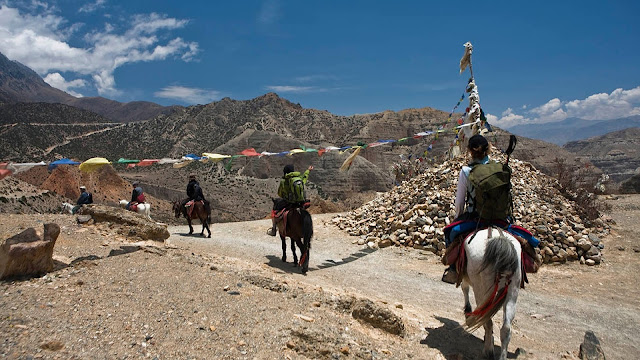To trek in Upper Mustang is a rare privilege. Here you will
experience the way of life of true mountain people, who were not much in touch
with the rest of Nepal for hundreds of years, and even until recent times
had an officially recognized king.
In many ways, a
trek into Upper Mustang is
similar to trekking in Tibet, as geographically it is a part of
the Tibetan plateau. The district of Mustang was, until 1950, a separate
kingdom within the boundaries of Nepal. The last king, the Raja of Mustang,
still has his home in the ancient capital known as Lo Manthang.
Upper Mustang
was opened to non-Nepali trekkers only some fifteen years ago and even today,
access is still highly restricted. To enter Upper Mustang, that is to travel
further north from Kagbeni, trekkers need special trekking permit and
must be accompanied by a government appointed officer.
Upper Mustang,
being in the Himalayan rain shadow, is one of the regions in
the country suitable for trekking even during monsoons. During
this time, the upper Kali Gandaki valley is still quite dry with only
occasional rainfall.
The Mustang
trek is not particularly difficult, the highest point reached being only 3,800
meters, but the conditions at times can be arduous. Mustang is cold in winter
and is always windy and dusty through the year. Winter treks are best avoided
due to harsh weather.
There are few
accommodation facilities available above Kagbeni, so groups must be fully
self-sufficient, especially in fuel. While porters are available in Jomsom it
is preferable to use mules to carry the loads up to Mustang. These pack animals
are available locally and are more economical, and certainly more
environmentally friendly than porters.
Mustang trek
requires a minimum of 9 days, starting and ending in Kagbeni. This allows the
trek to be completed within the 10-day period that the permit allows. The route
generally follows the Kali Gandaki valley but, occasionally climbs high above
the valley walls.
The settlements
are scattered and there is little sign of cultivation between villages. In
Mustang, little grows without irrigation, thus the region resembles a desert
albeit mountainous, nuclear settlements in fertile areas.
Lo Manthang,
the old capital, is reached in four days and at least one extra day should be
spent here to catch the sights and sound of this unique walled settlement.
Ponies are available for hire if you so desire. The return trip can either
follow the same route while entering or, as an alternative route, the eastern
bank of the Kali Gandaki may be followed.













thank you for sharing the article and plz keep sharing these stuffs..Best car blog
ReplyDelete